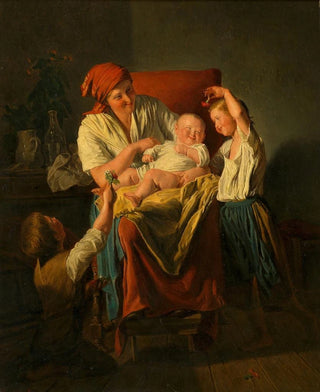Art print Mutterglück - Ferdinand Georg Waldmüller | Art print


View from behind

Frame (optional)
Mutterglück art print - Ferdinand Georg Waldmüller – Captivating introduction
In the vast panorama of art history, certain works stand out for their ability to capture deep and universal emotions. "Mutterglück" by Ferdinand Georg Waldmüller is a striking example. Painted in the 19th century, this piece evokes tenderness and the beauty of family bonds, depicting a mother and her child in a moment of gentle intimacy. Waldmüller, with his penetrating gaze and sensitivity, manages to transcend the simple portrait to offer a reflection on motherhood and the joy it engenders. The art print of this work allows you to immerse yourself in the emotional universe of the artist, while celebrating the beauty of human relationships.
Style and uniqueness of the work
Waldmüller's style is characterized by a realistic approach, imbued with great delicacy. In "Mutterglück", the meticulous details of the faces, the softness of the expressions, and the warm light bathing the scene testify to his skill in observing the world around him. The colors, both vivid and harmonious, create an atmosphere of serenity and happiness. The artist manages to establish a dialogue between the characters and the viewer, inviting this last to feel the tenderness emanating from this scene. Waldmüller does not merely depict a mother and her child; he immortalizes a precious moment, a grace that resonates with anyone who has known maternal love.
The artist and his influence
Ferdinand Georg Waldmüller, born in 1793 in Austria, is an emblematic figure of the Romantic movement. His career, marked by an incessant quest for beauty and emotion, has influenced many contemporary and later artists. Waldmüller is often praised for his ability to combine realism and idealization, creating works that touch the heart while remaining rooted in reality. His approach to genre painting, where he depicts scenes of everyday life with emotional depth, paved the way for a new way of seeing and representing humanity. By placing the individual at the center of his art, he managed to capture

Matte finish

View from behind

Frame (optional)
Mutterglück art print - Ferdinand Georg Waldmüller – Captivating introduction
In the vast panorama of art history, certain works stand out for their ability to capture deep and universal emotions. "Mutterglück" by Ferdinand Georg Waldmüller is a striking example. Painted in the 19th century, this piece evokes tenderness and the beauty of family bonds, depicting a mother and her child in a moment of gentle intimacy. Waldmüller, with his penetrating gaze and sensitivity, manages to transcend the simple portrait to offer a reflection on motherhood and the joy it engenders. The art print of this work allows you to immerse yourself in the emotional universe of the artist, while celebrating the beauty of human relationships.
Style and uniqueness of the work
Waldmüller's style is characterized by a realistic approach, imbued with great delicacy. In "Mutterglück", the meticulous details of the faces, the softness of the expressions, and the warm light bathing the scene testify to his skill in observing the world around him. The colors, both vivid and harmonious, create an atmosphere of serenity and happiness. The artist manages to establish a dialogue between the characters and the viewer, inviting this last to feel the tenderness emanating from this scene. Waldmüller does not merely depict a mother and her child; he immortalizes a precious moment, a grace that resonates with anyone who has known maternal love.
The artist and his influence
Ferdinand Georg Waldmüller, born in 1793 in Austria, is an emblematic figure of the Romantic movement. His career, marked by an incessant quest for beauty and emotion, has influenced many contemporary and later artists. Waldmüller is often praised for his ability to combine realism and idealization, creating works that touch the heart while remaining rooted in reality. His approach to genre painting, where he depicts scenes of everyday life with emotional depth, paved the way for a new way of seeing and representing humanity. By placing the individual at the center of his art, he managed to capture
12,34 €






